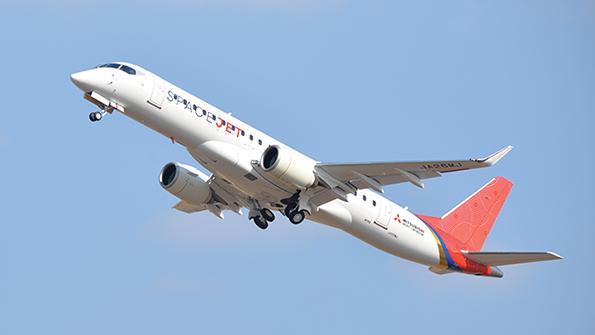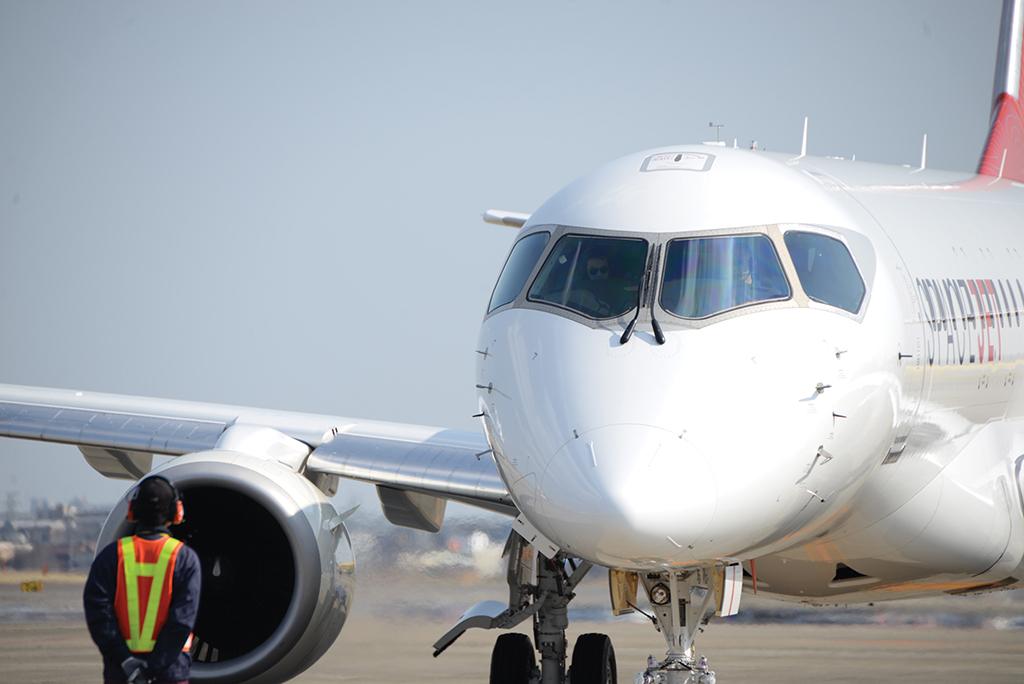
When Mitsubishi launched its regional jet program in 2008 the business case was questionable. Incumbent manufacturers Embraer and Bombardier dominated the regional jet market with an installed base of thousands of airframes, flight tests were already underway for the rival Sukhoi Superjet, and closer to home China was pouring considerable resources into its ARJ21 program.
Fast-forward 12 years, and many of those challenges have evaporated. Embraer is reeling from an aborted takeover by Boeing, Bombardier no longer makes commercial aircraft and Mitsubishi has acquired its CRJ program, the Superjet has flopped outside—and increasingly inside—Russia, and the ARJ21 has garnered little interest other than from China’s state-owned airlines.
But despite this implosion of the competition, the case for the Mitsubishi SpaceJet is as tenuous as ever. The havoc wrought on the airline industry by COVID-19 is one reason for this, but even before the pandemic the Japanese regional jet program was grappling with multiple delays and a limited orderbook.
In May 2019, seeking to draw a line under the program’s internal troubles, Mitsubishi Aircraft rebranded it from the MRJ to the SpaceJet, focusing on the 90-seat M90 (then in flight tests) and also launching a new 76-seat variant, the M100, which would be scope-clause-compliant for the U.S. market.

Only a few months later, U.S. regional airline group Trans States canceled an order for 50 M90s due to scope-clause concerns. At the time, Mitsubishi said it was in talks to replace the order with the M100, but then COVID-19 struck, and by May of this year the company was forced to announce suspension of the M100 program and a halt to flight testing of the M90.
Mitsubishi Aircraft is now reporting 287 orders and options for the M90. Of those, 163 are firm orders, although these include 100 from SkyWest, a U.S. regional airline group that faces the same scope-clause obstacle as Trans States. That means a big question mark hangs over its order.
Given this situation, many wonder why Mitsubishi has not scrapped the SpaceJet program altogether. And the finance department of Mitsubishi Aircraft’s parent—Mitsubishi Heavy Industries (MHI)—may have agreed, after the SpaceJet program accounted for almost all its ¥71 billion ($670 million) loss in the three months ending on June 30, 2020.
MHI estimates that fiscal 2020 development costs for the SpaceJet could be ¥60 billion. And while this is less than half the previous budget, commercial considerations about the program appear to have become entangled with national strategic objectives—and pride.
“We are developing the first commercial jet for Japan,” says a representative for Mitsubishi Aircraft. “This is significant, not only for our company but also for our country. Working closely with our business partners and the [Japan Civil Aviation Bureau], we are establishing the foundation for the commercial aviation industry in Japan.”
Program Status
Although Mitsubishi Aircraft has paused flight testing of the M90 at its Moses Lake, Washington, testing site in the U.S., the company is continuing to work toward type certification for the regional jet.
In February, Mitsubishi Aircraft said that the SpaceJet would enter service in April 2021 “at the earliest.” But now the company will not disclose a target date for type certification or for entry into service of the M90, stating that plans for the former will proceed once Mitsubishi Aircraft completes its reorganization and restructuring. Part of that process included the appointment of Yasuhiko Kawaguchi as executive chief engineer. Kawaguchi had a key role in the M90’s flight-test program, which produced 3,900 hr. of data that now needs to be validated. Mitsubishi has said it will also focus on “improving the current design at the aircraft level.”
“These are our priorities now,” says Jeff Dronen, director of strategic communications for Mitsubishi Aircraft. “Once we achieve type certification, at that point we will reevaluate the market and the needs of our customers and determine entry into service in line with their schedules.”
Regarding the effect of Mitsubishi Aircraft’s restructuring on its relationship with key suppliers, Dronen says: “COVID-19 has obviously had an impact on us and our partners. We all are suffering now, and we must work together as we move forward.”
He adds that organization of aftermarket support for the SpaceJet will be determined closer to the M90’s type certification.
“Once we have a clear vision to achieving [type certification], then we will begin reevaluating the market and customer needs and determine the best approach for supporting our customers and our aircraft,” Dronen says.
Although as yet there are no details on how Mitsubishi Aircraft will support the SpaceJet, it may well gain some valuable insights from its parent company’s acquisition of the CRJ program from Bombardier. MHI closed the deal in June, acquiring the maintenance, support, refurbishment, marketing and sales activities for the CRJ series, plus their type certificates. The sale included Bombardier’s CRJ services and support network in Montreal and Toronto, as well as its service centers located in Bridgeport, West Virginia, and Tucson, Arizona.
Following the deal, an MHI representative says the company has become “the largest maintenance and support provider for the CRJ family of aircraft.” The representative adds: “The SpaceJet program will be able to take full advantage of this unparalleled customer support workforce and be ready to jump back into the competition once it fully restarts the program.”
The Long Game
Despite Mitsubishi’s tortuous development of its regional jet—the original iteration, the MRJ90, was supposed to have entered service in 2013, but the first flight-test vehicle rolled out in 2014—the company still has time on its side. The COVID-19 pandemic means there is scant demand for new aircraft at present and probably for the next year at least and thus little chance for competitors to steal a march on the SpaceJet.
Commenting on the state of the regional aircraft market, Dronen says that Mitsubishi Aircraft’s “research is in line with recent industry analysis, and we expect that it will take several years to recover to the previously expected levels.”
Another point in favor of a further extension to development is that Embraer is the only player of note left in the regional jet market. Yet there is a huge fleet of aging regional jets that will need to be replaced over the next decade, a process that airlines and lessors would prefer not to enter being on the wrong side of a monopoly.
Completed before the pandemic, Embraer’s most recent market outlook projects demand for 10,500 aircraft of up to 150 seats in 2019-38, 45% of which will be replacements. Over the same period, Boeing forecasts deliveries of 2,240 regional jets, a category in which aircraft like the M90 and Embraer 175-E2 are at the top end of the size range.
Both the M90 and the Embraer E2 line use variants of Pratt & Whitney’s PW1000 family of geared turbofan engines. The appeal of the efficiency gains these offer over current-generation powerplants is somewhat negated by scope-clause restrictions in the critical U.S. market, which accounts for almost half the global regional jet fleet. Both the M90 and E175-E2 are excluded from this market due to their maximum takeoff weights.
One result of this has been continued demand for the current-generation E175, which is scope-clause-compliant. Prior to the pandemic, most analysts expected 2023 to be the next date when renegotiation of scope clauses might be possible, although few predict success in such talks.
However, COVID-19 has upended the airline industry in ways that are only beginning to be felt. One unforeseen consequence may be a loosening of scope-clause restrictions by U.S. unions. And even if that does not happen, there remains a large market outside the U.S. into which both Embraer and Mitsubishi are hopeful of selling. Failing that, the Japanese company also has the option of restarting development of the M100.
Yet the long term brings its own challenges. The further Mitsubishi extends SpaceJet development, the closer it may find itself in conflict with new technologies such as ultra-high-speed rail and electric aircraft, not to mention changing societal attitudes toward the environmental impact of flying.
While electric aircraft are still an unproven concept, the 90-seat M90 lies at the upper end of what aerospace engineers think might be possible for commercial passenger airliners using electric powerplants.





